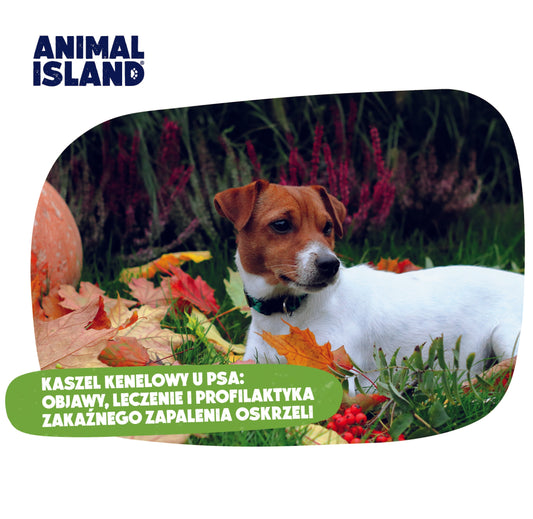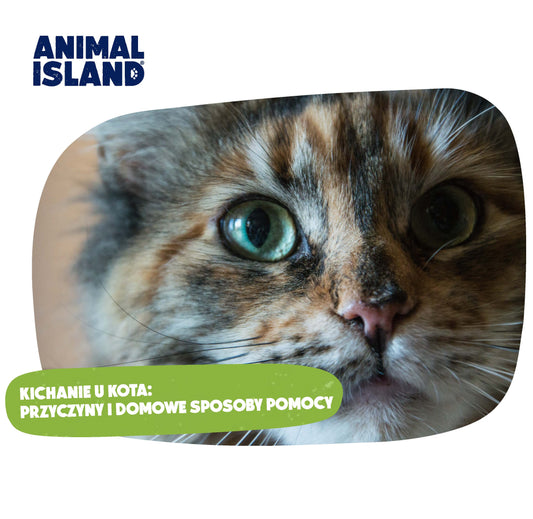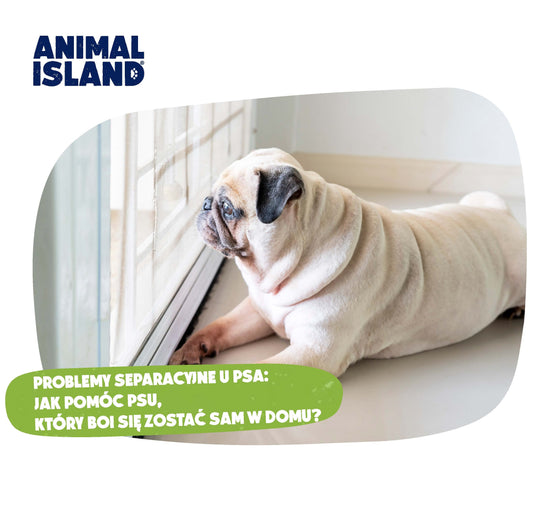How to change dog food and introduce new one safely?

POOR BELLY
Has it ever happened to you that you changed your dog's food and he had stomach problems? Your dog looked at you with big, sad eyes and a revolution was happening in his tummy... Every Guardian also knows the moment when a dog eats something that is not in his daily diet. No later than the next day, symptoms such as vomiting and very poor well-being appear, such situations can be prevented, that is why we come to help and advise!
SYMPTOMS OF STOMACH PROBLEMS
Your pet is behaving in a way that may indicate digestive problems? It is important to quickly understand the situation.
Gas: The buildup of gas in the digestive tract that can be expelled as wind is a result of digestion. Certain foods and situations can cause more gas production.
Diarrhea: Certain foods and situations can cause more gas. Diarrhea in dogs is a condition in which your dog passes loose, watery stools more often than usual. It is a symptom, not a disease in itself. Diarrhea can be acute, coming on suddenly and lasting a short time, or chronic, lasting a long time.
Vomiting: This is a defense mechanism of the body. Frequent or recurrent vomiting may indicate stomach problems.
Bloat: Bloat in dogs is a condition where their tummy becomes enlarged and tense due to a buildup of gas, fluid, or food in the stomach or intestines. Bloat can be uncomfortable and painful for your pet.
Excessive salivation: May be a sign of nausea.
Tummy ache, soreness: Your dog may feel uncomfortable, be restless, whine, or avoid having his belly touched.
Loss of appetite: Your dog may instinctively not want to eat or avoid meals. Animals often respond to food ailments by fasting.
Watery eyes: If you notice your dog has chronic watery eyes, redness, swelling, or discharge, it is worth considering stomach issues.
Paw Licking: There are a number of reasons why your dog may be licking their paws, including digestive issues. Food intolerances are different from allergies in that they do not involve the immune system, but they can cause digestive discomfort, which can manifest as itching or skin irritation, leading to paw licking.
Lethargy: Reduced activity and lack of energy can indicate digestive problems and soreness. Check your dog for any visible abdominal girth or hardness.
Dehydration: This most often occurs as a result of vomiting or diarrhea.
Behavioral changes: As a result of feeling unwell, your dog may become more irritable or withdrawn.
THE CAUSE OF SUFFERING
This situation usually occurs due to the use of an inappropriate diet in the form of too many carbohydrates and legumes. Often we want to do well and it turns out completely differently... Changing food or introducing new foods without a gradual transition can cause gastrointestinal disorders. Also, a lack of the right amount of fiber in the diet can lead to constipation or other intestinal problems. Everything takes time!
The culprit may also be food ingredients such as: grains, raw vegetable proteins - such as soy or beans, peas, artificial additives, or chicken. To avoid problems and spare your pet suffering, it is worth considering changing the food by carefully reading its ingredients.
Food intolerance and allergy to milk, fructose, lactose or gluten can also lead to flatulence. Gluten intolerance is especially visible when feeding a dog food containing grains.
Another cause of excessive gas in dogs is overly greedy consumption of food. The dog, rushing to the bowl and swallowing food at a fast pace, swallows excess air in the process. There are dog breeds predisposed to gastric problems associated with excess gas secretion. These are brachycephalic breeds (short snouts), such as English bulldogs, French bulldogs, boxers, pugs, Pekingese, and shih-tzus.
Dogs that do not get enough physical activity also tend to have gastric problems. Movement has a positive effect on intestinal peristalsis. However, it is important to remember that the digestive process in dogs is longer than in humans. It is worth providing the dog with enough time to digest after a meal without forcing it to engage in much physical activity.
“Whether or not the father of the disease was, poor diet was certainly its mother.”
Chinese proverb
HEALTH BEGINS FROM THE BELLY
Did you know that 70% of your pet's immunity comes from the intestines?
A healthy diet for a dog is the foundation of his well-being and overall health. What we feed him is very important for the mental and physical condition of our pet. A healthy dog has a shiny coat, is full of energy and is not overweight or underweight, which indicates effective absorption of nutrients. A dog should eat willingly and have a stable appetite, without sudden changes. The feces of a healthy dog should be well-formed, not too hard or too soft. This is what characterizes us dog lovers on walks... Yes... We observe the poop! 😊 The color should be brown, and bowel movements should take place regularly, usually once or twice a day.
To sum up, a healthy belly is:
- · regular and normal bowel movements,
- · no bloating or excessive gas,
- · healthy appetite,
- · no vomiting, diarrhea, abdominal pain,
- · good physical condition and vitality,
- · healthy skin without dandruff, beautiful and shiny coat
- · fresh breath.
MENU FOR A HEALTHY BELLY
We change dog food – what is worth knowing? A bit of theory to better understand what a healthy diet your pet is. There are a few details, differences in the ingredients of daily meals or methods of preparation that are worth knowing. In the rest of the article, we reveal these secrets 😊 . If your dog knew how much you are involved in its healthy tummy, it would wag its tail!
Animal protein vs. plant protein
Animal protein and plant protein differ in several ways that are important in the context of a dog's diet. Animal protein is usually more digestible for dogs than plant protein. This means that the dog's body can use the amino acids from animal protein better and faster.
Proteins are made up of amino acids, which are essential for the body to function properly. Animal proteins typically contain all the essential amino acids that dogs need in the right proportions. These are often called complete proteins. Plant proteins, on the other hand, may not contain all the essential amino acids or may contain them in smaller amounts, which is why they are sometimes considered less valuable in terms of completeness.
Plant proteins often come from seeds, grains, and vegetables, which can also provide carbohydrates. Animal proteins, such as meat, fish, eggs, and dairy, are also sources of fat, which are an important source of energy for dogs.
Animal proteins often contain more fat than plant proteins, which can affect the caloric content of the meal. Dogs, as carnivores, can draw energy from fat more efficiently than from carbohydrates.
Animal proteins tend to have a higher biological value, which means they better meet your dog's nutritional needs.
In conclusion, animal protein is much more beneficial for your dog.
Dried and fresh fish
Look for fresh and dried fish in the ingredients. A good fish likes to affect... health! Both fresh and dried fish can be a valuable addition to a dog's diet, provided they are fed properly. It is important to choose high-quality products, and make sure they do not contain bones that could harm the dog.
Fresh fish are an excellent source of protein, which is essential for building and regenerating tissue. In addition, fish, especially oily fish such as salmon, mackerel, and sardines, are rich in omega-3 fatty acids, which support healthy skin, fur, and the cardiovascular system. It is also worth noting that fresh fish provide many vitamins (e.g. D and B12) and minerals (e.g. iodine, selenium).
Stop allergens
Beware of allergens! When your dog is suffering from allergies, he is extremely unhappy. Food allergies in dogs are relatively common and can be caused by a variety of dietary components. Below we list some of the most common food allergens in dogs.
Dairy: Dairy products such as milk, cheese, and yogurt can cause allergic reactions in some dogs. Lactose intolerance is also possible.
Chicken: Like beef, chicken is commonly used in dog food and may be an allergen.
Eggs: Some dogs may be allergic to egg protein.
Grains: Grains such as wheat, corn and soy can cause allergies in dogs, although these are more likely intolerances than true allergies.
Pork: May also be a potential allergen, although less frequently than other protein sources.
Observe your dog's reactions after a meal and check the ingredients, you will surely notice which ingredients are not tolerated. Sherlock Holmes would be proud of you!
Accessories for beauty and freedom
Accessories are always a plus – but! The introduction of additives to the dog's diet should be well thought out, especially if the dog has specific health issues. It is important to properly balance the diet to support the overall health of the dog.
To support the digestive tract:
Probiotics: Helps maintain healthy gut flora, supporting digestion and nutrient absorption. Probiotics can also improve immunity.
Prebiotics: Dietary fiber that supports the growth of beneficial bacteria in the gut. Inulin and FOS (fructooligosaccharides) are popular prebiotics.
Fiber: Helps regulate bowel movements and can be helpful in cases of constipation or diarrhea. Sources of fiber include pumpkin, bran, and psyllium seeds.
Digestive enzymes: May aid digestion and nutrient absorption, especially in dogs with digestive issues.
Glutamine: An amino acid that supports gut health and may help regenerate the intestinal lining.
For a beautiful and shiny coat:
Omega-3 and Omega-6 Fatty Acids: Found in fish oils (e.g. salmon oil) and flaxseed oil. Supports healthy skin and coat by reducing dryness and flaking.
Biotin: Supports healthy skin and coat, and strengthens claws. Can be found in animal food supplements.
Zinc: Helps maintain healthy skin and coat. Zinc deficiency can lead to skin problems.
B Vitamins: Such as B2 (riboflavin), B3 (niacin) and B7 (biotin) which support healthy skin and coat.
Evening Primrose Oil: Contains gamma-linolenic acid (GLA), which may help improve skin and coat condition.
Collagen: Supports healthy skin, coat and joints. Can be added as a powder to food.
Deliciousness on the podium
The palatability of food has a significant impact on a dog's nutrition, because it affects its appetite. Just like you, your pet simply likes to savor a good meal! It's completely understandable, which is why high palatability is so important in every dog's diet.
BIG MENU CHANGES
We have already chosen a new food that meets the important standards described in the previous part of the article. We have another task ahead of us - how to switch to the new food and not harm the pet.
Transitioning to a new food for your pet should be done gradually to avoid digestive problems and minimize the stress associated with the change in diet.
Gradual introduction : Start by mixing a small amount of the new food with your pet's current food. It is usually recommended to allow 7 to 10 days for this process. You can use the following schedule.
The transition scheme to a new food – the magic 10
Day 1-3 - 25% new food - 75% current food
Day 4-6 – 50% new food – 50% current food
Day 7-9 - 75% new food – 25% current food
Day 10 -100% new food
When switching to a new food, avoid treats, mixing with wet food, and chews. Focus on introducing the new food and then pamper your pet again.
This transition time can of course be extended if we know that our pet has a sensitive digestive tract.
After 10 days, it takes another 2-3 weeks to determine whether the food is good for your dog. This is the time for adaptation to the new food and ingredients. Is there any gas, loose poop, etc.
After about 1.5 to 2 months, you can clearly state whether the new food suits your dog, you can observe positive changes such as the number of bowel movements (less), the condition of the skin and fur (no dandruff or allergies), maintaining the right body weight, etc.
Observation of reactions : Monitor how your pet reacts to the new food. Pay attention to any signs of discomfort, such as diarrhea, vomiting, or loss of appetite. If you notice any disturbing symptoms, consult your veterinarian
Regularity, routine: Set regular meal times for your pet and monitor them every day.
Adjusting the amount : Make sure that the new food provides the right amount of calories and nutrients. It may be necessary to adjust the portion size to avoid overweight or underweight.
Hydration : Make sure your pet always has access to fresh water, especially if you are switching from wet to dry food.
Mixed feeding : you can introduce one to the menu a meal in the form of wet food, but let it be at a fixed time, e.g. dinner or breakfast. This will enrich the dog's diet and ensure that dry food does not get boring so quickly.
Important rule: Never mix dry and wet food in one meal – feed them separately to support your dog's digestion!
WE GOT IT!
Dry food with salmon and white fish from Animal Island is the perfect solution for your pet!
Why? The answer is simple, it contains many essential ingredients for a healthy tummy of your dog. It is a solution to the dilemma related to choosing the right food 😊 . It contains as much as 81% protein of animal origin, in the first place in its composition are dried and fresh fish (salmon, plaice, cod), without allergens: cereals, peas, chicken, chicken fat and artificial and colorful additives. 100% natural food, contains additives to support the digestive tract and beautiful and shiny fur. And most importantly for those with a sweet tooth - very high palatability due to the high content of protein from fish, salmon oil and hydrolyzed pork liver.
“Proper nutrition will be the medicine of tomorrow.”
-Linus Pauling


 Wścieklizna
Wścieklizna

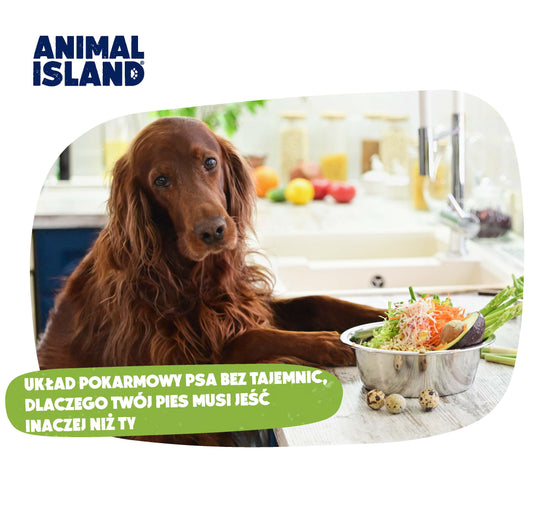

 Zęby i jama ustna – stworzone do chwytania, nie mielenia
Zęby i jama ustna – stworzone do chwytania, nie mielenia
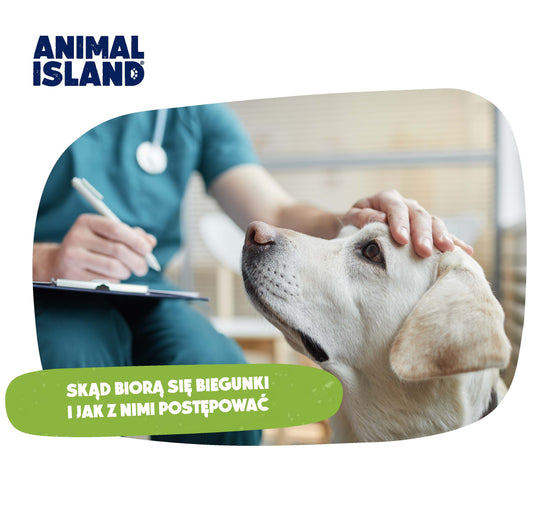



 ROZSĄDNA DIETA, BY ZAPOBIEGAĆ BIEGUNCE W PRZYSZŁOŚCI
ROZSĄDNA DIETA, BY ZAPOBIEGAĆ BIEGUNCE W PRZYSZŁOŚCI
